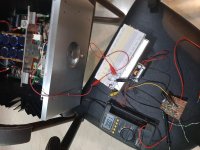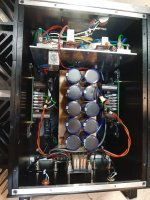Last edited:
170mV across meter ?
1.06mA through meter ?
for full scale needle position?
don't care for rest
( I mean - practically , current through meter is enough to calculate everything needed)
1.06mA through meter ?
for full scale needle position?
don't care for rest
( I mean - practically , current through meter is enough to calculate everything needed)
Last edited:
I admit I don't understand how you measure Through meter as per your diagram .. So I measure across.
I can't explain it better than it's already shown on sketch I posted
mV-meter is showing voltage across device under test ( needle meter)
mA-meter is showing current through device under test ( needle meter)
just connect everything as I drew , rotate pot to get max needle position and read mA
you don't need to understand
mV-meter is showing voltage across device under test ( needle meter)
mA-meter is showing current through device under test ( needle meter)
just connect everything as I drew , rotate pot to get max needle position and read mA
you don't need to understand

OK , now just write on meter case 1.09mA , to have it for later
when you decide what you want to monitor with that meter , say and we'll figure out where and how to connect it
stereo amp in that case, or mono ?
when you decide what you want to monitor with that meter , say and we'll figure out where and how to connect it
stereo amp in that case, or mono ?
just to let you know i emailed the supplier for the chassis. They said it is just a mains meter and i only need to attach the mains to it. The meter will be in the middle for 240v
ZM - I have a case that is similar with the meter also. I removed the circuit board from the meter case and soldered the leads from the meter to the 4 mm studs. I hooked it up to your test circuit and have the following measurements:
Meter resistance as measured across the terminals = 160.3 ohms
Source voltage was 1.8vdc
Current through the meter until full scale was 1.15 mA
With the 47K pot removed from the circuit, it was at 1.4K to achieve full scale.
How would I wire this into The Singing Bush as an Iq meter?
Meter resistance as measured across the terminals = 160.3 ohms
Source voltage was 1.8vdc
Current through the meter until full scale was 1.15 mA
With the 47K pot removed from the circuit, it was at 1.4K to achieve full scale.
How would I wire this into The Singing Bush as an Iq meter?
easypeasy
across entire big resistor group in Mu stage
negative end of meter to lower end of resistor group
then wire from upper end of resistor group , trimpot connected as variable resistor ditto to positive end of meter, 100uF cap across meter
rough calc is saying that 2K multiturn trimpot will cover for voltage across said resistor group , being roughly 1V2
or 1K fixed resistor in series with 2K trimpot ..... considering that you'll want center position of needle
across entire big resistor group in Mu stage
negative end of meter to lower end of resistor group
then wire from upper end of resistor group , trimpot connected as variable resistor ditto to positive end of meter, 100uF cap across meter
rough calc is saying that 2K multiturn trimpot will cover for voltage across said resistor group , being roughly 1V2
or 1K fixed resistor in series with 2K trimpot ..... considering that you'll want center position of needle
Thank you Zen Mod! That is easypeasy.
1K with 2K trimpot it is.
Why the 100uF cap across the meter? What is its purpose?
1K with 2K trimpot it is.
Why the 100uF cap across the meter? What is its purpose?
to prevent any possibility that needle goes to visit Shopping Center without you...... 
now seriously - that's not likely with this circuit - no leaving class A , no possible wild jumps in current through these resistors (everything is ramping up nicely and slow), but there is some varying voltage across that resistor group with signal, and you want to observe Iq, not modulation in any form; cap is there to slow things down , so needle is calm while you're jumping in the room, following da music

now seriously - that's not likely with this circuit - no leaving class A , no possible wild jumps in current through these resistors (everything is ramping up nicely and slow), but there is some varying voltage across that resistor group with signal, and you want to observe Iq, not modulation in any form; cap is there to slow things down , so needle is calm while you're jumping in the room, following da music
- Home
- Amplifiers
- Pass Labs
- Pass lab meter


